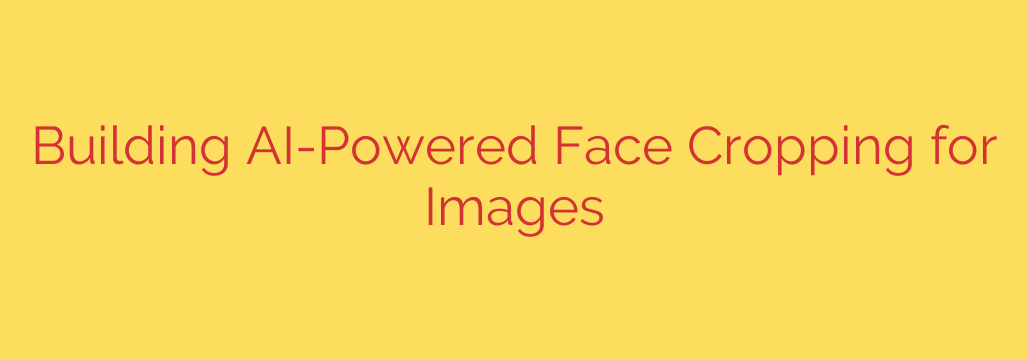
Mastering Image Composition: How AI-Powered Face Cropping Creates Perfect Thumbnails
In the digital world, first impressions are everything. Whether it’s a user profile picture, a blog post thumbnail, or a product image, a poorly cropped photo can instantly undermine professionalism and user engagement. We’ve all seen it: automated crops that cut off heads, focus on empty space, or awkwardly frame the subject. Traditional automatic cropping tools often fail because they lack a fundamental understanding of what makes an image compelling: its subject.
Fortunately, artificial intelligence is revolutionizing this process. By moving beyond simple center-crops, AI-powered face cropping technology intelligently identifies and frames human subjects, ensuring every thumbnail and profile picture is perfectly composed. This isn’t just about convenience; it’s about delivering a superior user experience automatically and at scale.
The Problem with Traditional Auto-Cropping
Standard cropping methods are typically based on simple, rigid rules. They might crop to the center of the image or use basic edge detection to find a general area of interest. This approach is fundamentally flawed because it ignores the most critical element in many photos: the people.
This results in common frustrations:
- Headless Portraits: The crop focuses on the torso, completely cutting off the person’s head.
- Awkward Framing: The subject is pushed to the very edge of the frame, creating an unbalanced and unprofessional look.
- Empty Focus: In wide shots, the crop might select an empty background, ignoring the people who are off-center.
These errors force manual corrections, costing valuable time and resources. For platforms that handle thousands of user-uploaded images daily, manual cropping is simply not a viable solution.
The Intelligent Solution: How AI Understands Composition
Modern AI-powered systems approach image cropping less like a machine and more like a human photographer. The process involves a sophisticated, multi-step analysis that prioritizes the human element and applies principles of good composition.
The core of this technology is its ability to not just find a face, but to understand its importance within the context of the entire photo. This ensures the final crop is not just accurate, but also aesthetically pleasing.
A Step-by-Step Look at Smart Face Cropping
Building an effective AI cropping system involves several key stages, each designed to make an intelligent decision.
1. Highly Accurate Face Detection
The process begins by scanning the image to locate all human faces. Unlike older, less reliable methods, modern computer vision models can detect faces with remarkable accuracy, even in challenging conditions like poor lighting, side profiles, or partially obscured views. The system identifies the precise coordinates of each face, creating a “bounding box” around it.
2. Prioritizing the Main Subject
In a group photo, which face should be the focus? The AI answers this by scoring each detected face based on several factors. The system typically prioritizes faces that are larger, more centrally located, and clearer. This allows it to identify the main subject or the most significant group of subjects, ensuring the crop is focused and relevant.
3. Creating an Aesthetically Pleasing Frame
This is where the “smart” cropping truly happens. Instead of just using the tight bounding box around the face, the AI expands that area to create a well-composed shot. It calculates the optimal frame to include the head, shoulders, and a balanced amount of surrounding space, mimicking the “rule of thirds” and other photographic principles. This prevents the cramped, “mugshot” look and produces a much more natural and professional result. For group shots, the AI calculates a single crop that elegantly frames the most important cluster of people.
4. Planning for Every Scenario
What happens if an image contains no faces at all, such as a landscape or product photo? A robust system needs a fallback plan. In these cases, the AI can switch to a different saliency detection model that identifies the most visually interesting region of the image, ensuring a sensible crop is always produced.
Practical Applications and Security Tips
This technology is already transforming how digital platforms handle imagery. Key applications include:
- Social Media and Community Platforms: Automatically generating perfectly framed profile pictures and content thumbnails.
- E-commerce Sites: Ensuring model headshots on product pages are consistent and professional.
- Content Management Systems (CMS): Allowing publishers to upload images for articles without worrying about manual cropping for different layouts.
- Digital Asset Management (DAM): Systematizing the cropping of vast photo libraries for consistent use across an organization.
For developers and businesses looking to implement such a system, a key security tip is to process all images on a secure, private server. Relying solely on third-party APIs for sensitive user-uploaded photos can introduce privacy risks. By building or hosting your own solution, you maintain full control over user data.
The Future is Framed Intelligently
As AI continues to evolve, its ability to understand context and aesthetics will only grow. AI-powered face cropping is a powerful example of how automation can move beyond repetitive tasks to replicate nuanced, human-like skills. By ensuring the human subject is always the star, this technology helps create a more engaging, professional, and visually appealing digital world.
Source: https://blog.cloudflare.com/ai-face-cropping-for-images/








